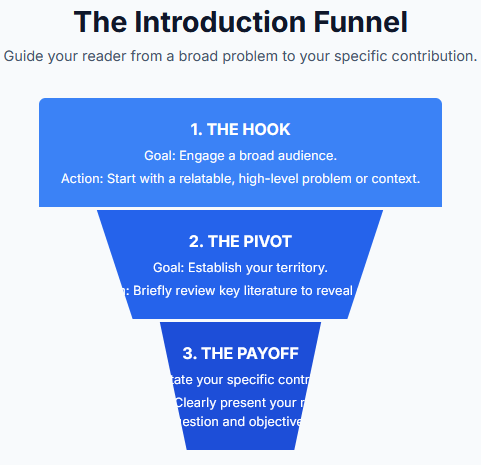The introduction is the most critical real estate in your research paper. It’s your one chance to grab a reader’s attention and convince them that your work is worth their time. Yet, many researchers treat it as a mere formality, a dry summary of what’s to come. The result? Papers that are technically sound but fail to make an impact because no one feels compelled to read past the first page.
A powerful introduction does more than just introduce; it creates a sense of urgency and intellectual curiosity. It tells a story that moves from a broad, recognisable landscape to a specific, intriguing problem that only your research can solve.
This guide provides a step-by-step framework for crafting an introduction that doesn’t just inform—it engages, persuades, and sets the stage for truly impactful research.
The Funnel Structure: Guiding Your Reader from Broad to Specific
Think of your introduction as a funnel. You begin with a wide opening that anyone in your broader field can relate to, and you systematically guide the reader down to the sharp, focused point of your specific contribution.
1. The Hook: Start with a Big, Relatable Problem
Your opening lines must connect with the reader on a fundamental level. Start not with your niche topic, but with the larger context in which it sits. Use a compelling fact, a surprising statistic, or a real-world example to establish the importance and relevance of the general area. This is how you draw the reader into your world.
Example: "Climate change stands as one of the most significant global challenges of our era. Despite widespread agreement on its urgency, the practical transition to renewable energy systems remains alarmingly slow, particularly in the urban centres where most of the world's population resides."
2. The Pivot: Bridge the General to the Specific
Once you have the reader's attention, you need to pivot toward your specific area of inquiry. Provide a brief overview of the existing research, highlighting what is known. Mention 4-6 key studies that have shaped the conversation. This isn't your full literature review; it's a strategic summary designed to do one thing: reveal a gap.
Example: "For years, studies on renewable energy adoption have rightfully focused on macro-level factors like policy frameworks and economic costs. Groundbreaking work by Smith (2020) and Jones (2021) has illuminated these areas. However, this focus has left a critical blind spot..."
3. The Gap: Establish Your Research Problem with Urgency
This is the most crucial turn in your introduction. You must clearly and confidently articulate the gap, problem, or unanswered question that your research will address. Frame it not as a simple omission in the literature, but as an obstacle to progress. This creates the tension that makes your work feel necessary.
Example: "...a significant gap in understanding the powerful role of individual human behaviour in driving—or stalling—adoption within urban communities. Without addressing these behavioural factors, policy solutions will remain incomplete."
The Payoff: Declaring Your Contribution and Plan
Having established the problem, you now present your solution. This part of the introduction is direct, clear, and serves as a roadmap for the rest of your paper.
4. State Your Objectives and Contributions Clearly
Leave no doubt about what your paper will accomplish. Use a clear thesis statement or a list of research questions/objectives to articulate your specific goals. Consider using formatting like bold or italics to make this section stand out. The reader should know, in no uncertain terms, what they will learn by reading on.
Example:
This study aims to fill this gap by addressing the following objectives:
Objective 1: To identify and analyze the key behavioral factors influencing urban renewable energy adoption.
Objective 2: To develop a framework for policymakers to address these behavioral barriers effectively.
5. Briefly Outline Your Methodology and Structure
Provide a concise summary of your research approach. You don't need to go into exhaustive detail—just enough to establish the credibility of your study. Finally, give the reader a clear outline of the paper's structure. This manages their expectations and provides a clear path forward.
Example: "To achieve these objectives, this study employs a mixed-methods approach, combining survey data from 500 urban residents with in-depth interviews. The following section reviews the relevant literature, after which the methodology is described in detail. The results are then presented, leading to a discussion of their key implications and directions for future research."
Final Thoughts
Your introduction is far more than a preamble; it is a strategic tool of persuasion. By structuring it as a compelling journey from a broad problem to a specific solution, you do more than just inform your readers—you make them care. You transform them from passive observers into engaged participants, eager to see how your story unfolds.
Frequently Asked Questions (FAQ)
- How is the Introduction different from a Literature Review section?
The Introduction provides a high-level, strategic overview of the literature to establish a research gap. It only includes the most essential studies needed to frame your problem. The Literature Review section is a comprehensive, in-depth analysis of all relevant scholarly work, where you discuss theories, methodologies, and findings in detail. - Can I write my introduction last?
Many experienced writers do. Writing the introduction after you've completed the rest of the paper allows you to frame the problem and outline the paper's structure with perfect clarity, as you already know exactly what the findings and conclusions are. - How do I avoid making my introduction sound like a list of facts?
Focus on creating a narrative flow. Use transitional phrases to connect your ideas logically (e.g., "While these studies have shown...", "However, a critical gap remains...", "To address this problem..."). Think of it as telling a story where each paragraph builds on the last, creating momentum and pulling the reader forward.


